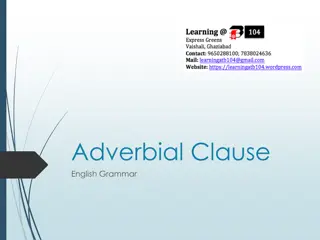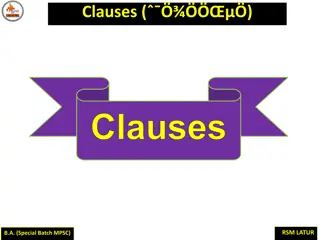Understanding Adverbial Clauses in English Grammar
Adverbial clauses in English grammar serve as adverbs to modify verbs, providing information about time, place, cause, contrast, condition, purpose, result, and manner. By exploring the types of adverb clauses, subordinating conjunctions, and examples, you can enhance your understanding of how adver
0 views • 10 slides
Understanding Adverb Clauses: Usage and Examples
Adverb clauses help to establish relationships between ideas by indicating time, cause and effect, contrast, and condition. They are dependent clauses that must be connected to a main clause. Punctuation plays a key role in distinguishing between adverb clauses that precede or follow a main clause.
0 views • 43 slides
Understanding Clauses and Their Types in English Grammar
This comprehensive guide explores different types of clauses in English grammar, including main clauses, subordinate clauses, independent clauses, adverb clauses, noun clauses, and adjective clauses. It delves into the functions of clauses as subjects, objects, complements of verbs, objects of prepo
2 views • 11 slides
Understanding Adverb Clauses: Types and Examples
Adverb clauses are dependent clauses that function as adverbs to modify the main clause's verb. They are connected by subordinating conjunctions and come in types like time, condition, cause, effect, and contrast. Adverb clauses of time detail when actions occur, while examples showcase how they mod
5 views • 7 slides
Understanding Complements in Grammar
The word "complement" originates from Latin meaning to fill up or complete and is essential in completing the meaning of a verb. Complements can be a noun, pronoun, or adjective but never an adverb. They are never found in a prepositional phrase. Learn about direct objects, indirect objects, and pre
0 views • 15 slides
Correct Usage of Adjective and Adverb Comparisons
Learn how to correctly compare adjectives and adverbs using the positive, comparative, and superlative forms. Avoid common mistakes like double comparisons and ensure you use the right form based on the number of items being compared. Improve your grammar skills with clear examples and revisions for
0 views • 14 slides
Understanding Modifiers: Misplaced, Dangling, and Adverb Placement
Learn about the concepts of misplaced modifiers, dangling modifiers, and adverb placement through clear examples and explanations. Practice fixing sentences with modifier errors and enhance your writing skills. Access additional practice resources to strengthen your understanding and application of
0 views • 7 slides
Learn to Use Adverbs in Independent Writing for Year 1 English
Explore the world of adverbs with engaging activities like identifying adverbs in sentences and using them creatively in independent writing. Enhance language skills as you describe actions with adverbs like quietly, cheerfully, skillfully, and more. Access lesson materials and practice adverbs with
0 views • 15 slides
Understanding Inversion in English Grammar
Inversion in English grammar refers to the reversal of the usual word order of a subject and a verb in a sentence. This reversal often occurs when starting a sentence with an adverb or adverbial phrase of place, creating a more dramatic effect. Inversion is also seen in direct speech, where the subj
0 views • 11 slides
Images depicting various frequency adverbs
Explore visual representations of different frequency adverbs like "always," "usually," "sometimes," "hardly ever," and "never" through a series of descriptive images. Each image showcases the corresponding adverb with an accompanying description, providing an engaging way to learn and understand th
0 views • 5 slides
A Guide to Using Conjunctive Adverbs in Compound Sentences
A conjunctive adverb is an adverb used to connect clauses or parts of a sentence. When joining compound sentences with conjunctive adverbs, use a semicolon and a comma. Examples and guidelines are provided for proper usage. Practice formulating compound sentences with conjunctive adverbs to enhance
0 views • 7 slides
Understanding Complex Sentences and Clauses
Complex sentences consist of an independent clause and at least one dependent clause, such as adjective, adverb, or noun clauses. They are connected using subordinate conjunctions, relative pronouns, and relative adverbs. Each has a specific role in modifying nouns, pronouns, verbs, adverbs, or conn
0 views • 14 slides
Understanding Adjectives and Adverbs Usage: Common Errors and Differences
Adjectives modify nouns and pronouns, while adverbs modify verbs, adjectives, and other adverbs. Learn the differences, common errors, and how to distinguish between commonly confused adjective/adverb pairs like real/really and sure/surely. Enhance your understanding of when to use each correctly.
0 views • 7 slides
Understanding Grammar Terms in Business Translation (ENB4202)
Explore key grammar terms such as action verb, adjective, adverb, article, clause, coordinating conjunction, dependent clause, gerund, linking verb, noun, noun phrase, object, phrase, preposition, pronoun, and subject in the context of business translation. Learn their definitions, functions, and ex
0 views • 14 slides
Understanding the Difference Between "Bad" and "Badly
Learn the distinction between "bad" and "badly" in grammar. "Bad" is used as an adjective after sense or linking verbs, while "badly" is an adverb used after all other verbs. Examples and test sentences included to enhance understanding of correct usage.
0 views • 5 slides
Recognizing Adverbs of Time, Manner, and Place in Sentences
This learning material provides images of words, prompting the identification of adverbs of time, manner, and place. Students are tasked with categorizing each adverb in the correct section of a grid to enhance their understanding of different types of adverbs.
0 views • 5 slides
Understanding Phrases and Clauses in English Grammar
This content dives into the concepts of phrases and clauses in English grammar, presented by Assistant Professor Dhanaji V. Thore. It explains how a phrase is a group of related words lacking a subject and predicate, while a clause contains both a subject and a predicate to form a complete sentence.
0 views • 23 slides
Understanding Phrasal Verbs in English
A phrasal verb is a combination of a verb and a preposition/adverb that forms an idiomatic expression with unique meanings. They can be intransitive or transitive, and the position of the object in phrasal verbs varies. Learn about the different types of phrasal verbs and how they are used in senten
0 views • 9 slides
Grammar on the Go! Unit 5 Lesson 7 Sentence Corrections & Clauses
This content focuses on sentence corrections in red, defining vocabulary words, and understanding different types of sentences such as compound, complex, simple, and compound/complex. It also covers identifying sentence types like declarative, imperative, interrogative, and exclamatory. Additionally
0 views • 9 slides


















